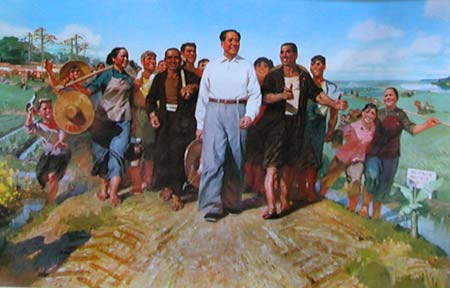FAR EASTERN ECONOMIC REVIEW, JUNE 10, 1993
Mao Fever Enriches His Home Town
By PAUL MOONEY in Shaoshan
The people of Shaoshan make no bones about it. This is the 100th anniversary of the birth of their favourite native son, Mao Zedong, and they are hoping to make a fast capitalist buck off the 1.5 million Chinese expected to make the pilgrimage to the small dusty village this year.

Local entrepreneurs are riding the coat-tails of Maore, or Mao fever, which kicked off following the June 1989 crackdown against the democracy movement, when taxi and truck drivers and small businessmen began adorning their vehicles and shops with Mao portraits. The spirit of the Great Helmsman, they say, not only drives away evil, but also brings in cash-carrying customers.
That millions died as a result of disastrous Mao initiatives such as the Great Leap Forward and the Cultural Revolution seems to matter little to the more than four million people who have trekked here since 1989. Many of them--either too short on memory or years to remember the chairman’s excesses--see the Mao era as the golden age of clean and efficient government when people were more equal, and they spring to his defence.
“Nobody’s perfect,” says a Hubei businessman named Wang who moved to Shaoshan with two friends in April after making a trip to the village and seeing the potential for doing business there. “Mao made a lot of mistakes, but his contributions were greater than his mistakes,” says Wang, echoing the oft-repeated party line.
If Mao has been elevated to folk god (god of wealth may be more apt) the treatment of the late communist leader is nothing less than sacrilegious, and sometimes borders on the absurd.
Visitors to Shaoshan, two hours south of Changsha, the capital of Hunan, are greeted by rows of souvenir shops and clusters of itinerant hawkers selling a wide array of tacky Mao-morabilia. In addition to Mao badges, visitors snap up pocket watches, T-shirts, umbrellas, tie clips, ball-point pens, calendars, heart-shaped lockets and musical cigarette lighters that play The East is Red when the cover is flicked open. From the doors of one government-run shop, a cassette player blasts a speech by Mao. His words gradually recede into the background, replaced by increasingly loud disco music and songs extolling the virtues of the Great helmsman.
At Dishuidong, a resort where Mao spent 11 days in 1966, a constant stream ofvisitors file past the room where Mao slept, the study where he worked, andthe ping-pong table he played on. Even Mao’s private bathroom is on display, with visitors filing by to peer through the window at the bathtub, toilet and urinal that Mao used.
Another room houses a collection of several thousand Mao badges on loan from a Shanghai collector. The badges, a mini-history of contemporary China, are made of 26 types of materials, including plastic, gold, silver, jade, bone, stone, bamboo, shell and porcelain. There are standing Maos, applauding Maos, young revolutionary Maos and even fluorenscent Maos that glow in the dark. One series shows Mao together with old comrades, many of whom later had a falling out with him. On one, the face of Lin Biao, the former military leader and would-be Mao successor until he died mysteriously in 1971, was prudently scratched away.
Budhism and Christianity are also making a comeback with the man who converted temples and churches into warehouses. Statues of the Buddhist and Christian icons stand on shop shelves alongside Mao busts. A group of primary school children walking through Mao’s ancestral home are bedecked with Mao paraphernalia intertwined with crucifixes. Although none proffesses to be a Christian, they know the man on the cross is “Yesu,” or Jesus. On the back of a crucifix hanging from the neck of one small boy are the English words: “I am a Catholic. In case of an accident please call a priest.”
Tian Yongjun, a farmer’s son, recognised opportunity when he saw it knocking on the village door. Noticing that most of the Mao souvenirs sold here were produced outside Shaoshan, the 24-year-old factory worker sent his younger brother to neighbouring Hubei province to learn how to turn out Mao statues.
Tian is now the general manager of the Shaoshan Statue Co., which opened on his father’s farm last June, and which employs three women turning out 20 different Mao figures. In less than one year of business he has already sold more than 20,000 Maos all over China. His average monthly sales of Rmb 6,000 (US$1,050) give him a profit of Rmb 2,000, more than 10 times his monthly salary at the factory.
After Mao, Shaoshan’s second most famous native could well be Tang Ruiren. Tang, a white-haired, spunky grandmother, is the owner of the Mao Family Restaurant, which opened in 1987 (two other Mao Family Restaurants have since sprung up), located just across the paddy-field from the house where Mao was born, and a popular point on the Mao pilgrimage.
Her claim to fame is that Mao visited her here in 1959 and she proudly displays a poster-sized black-and-white photograph of herself together with Mao. She serves up his favourite dishes spiced with the fiery-hot red peppers for which the province is well known.
But while she insists, “I am not a capitalist. I am a socialist,” like other entrepreneurs in Shaoshan, Tang is more interested in economikc reform than revolution. “Chairman Mao was concerned about te livelihood of the people, that they have enough to eat, a house to live in and enough money to use,” says Tang. “If he came back to Shaoshan today he certainly would be very happy to see that we are all doing so well.